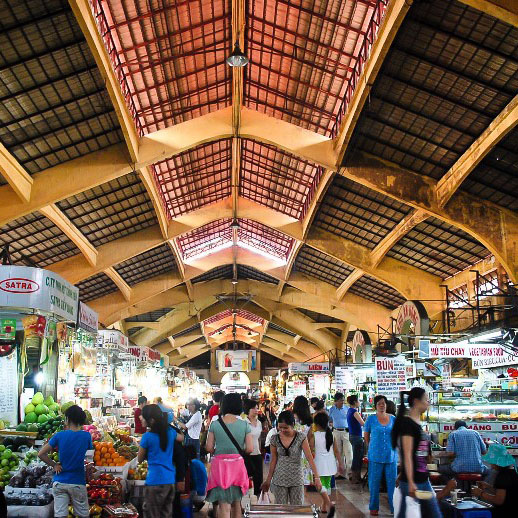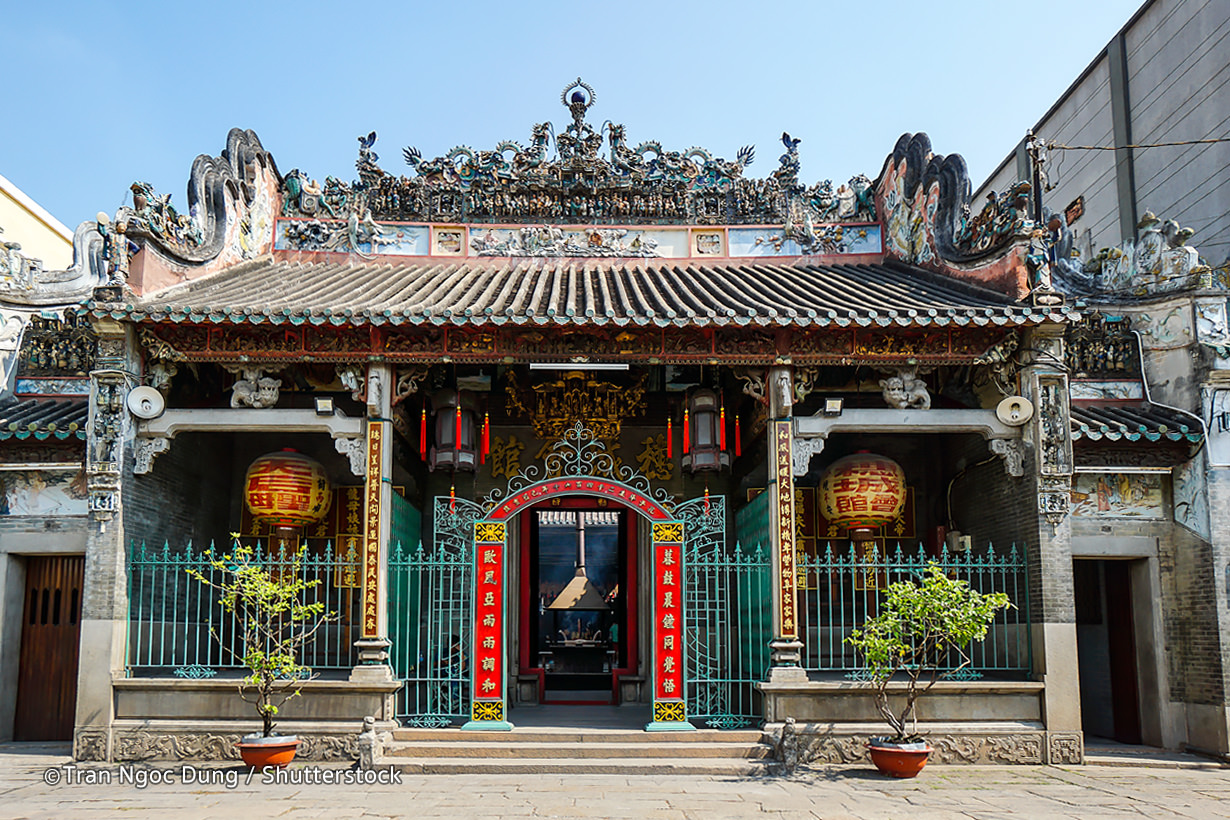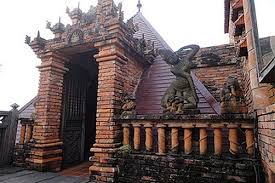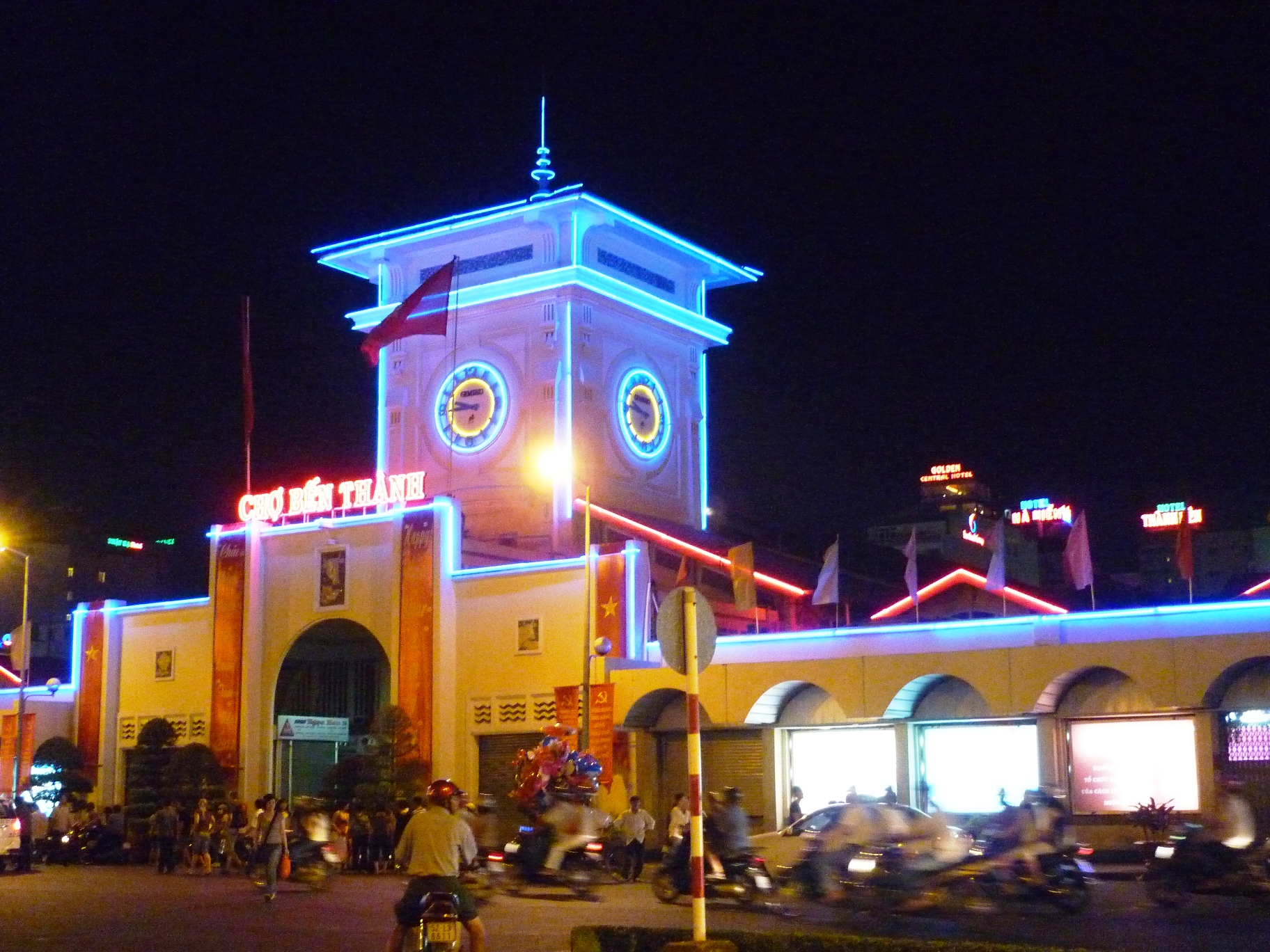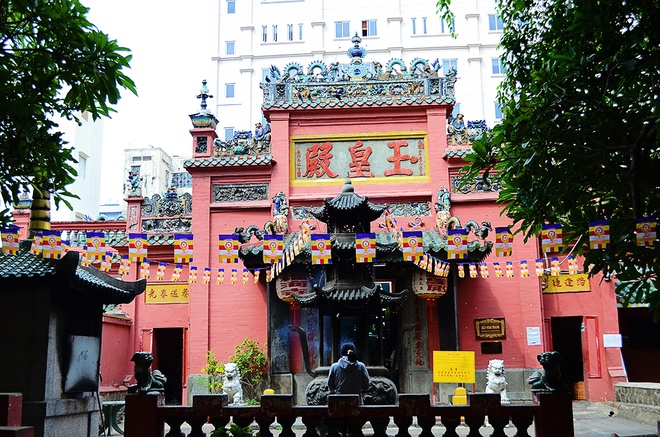HO CHI MINH
12 TOP – RATED TOURIST ATTRACTIONS IN HO CHI MINH CITY
Still often referred to by its old name, Saigon,Ho Chi Minh City is Vietnam’s commercial hub and largest city, and it’s a place where old abuts new with striking contrast. Temples huddle amid skyscrapers and designer shops; locals cast bamboo fishing rods into the languorous Saigon River; and in places, the city feels almost European, with its elegant French colonial architecture and wide, tree-lined avenues.
For more ideas on the best places to visit and the most rewarding things to do, read Xuan Son travel list of the top attractions in Ho Chi Minh City.
1.Cu Chi tunnel
About 60 kilometers from Ho Chi Minh City, the Cu Chi Tunnels are a must-see half-day trip and one of the top tours for visitors to the city. This vast 250-kilometer-plus network of tunnels served as the base for the Viet Cong’s military operations during the Vietnam War. Soldiers used the excruciatingly cramped tunnels as hiding places, hospitals, communication bases, supply routes, and even living quarters.
A visit usually includes the chance to crawl through part of the tunnel network, an experience that enhances your appreciation for the stamina and adaptability of the soldiers who lived here. Even if you’re not a fan of modern military history, the tunnels offer powerful insight into the conditions faced by troops during the conflict and the strategies that strengthened the VC’s resistance against American forces.

2.The War Remnants Museum
The War Remnants Museum is one of the most popular museums in Vietnam, with harrowing exhibits related to the horrors of war in this battle-worn nation. The museum primarily focuses on the Vietnam War, however, some exhibits relate to the first Indochina War with French colonialists.
Period military vehicles and weapons are displayed in the museum’s courtyard. After touring the countryside and the Cu Chi Tunnels, you’ll find these exhibits even more moving, but note that some of the exhibits are not suitable for small children.
3. Golden Dragon Water Puppet Theatre
The Golden Dragon Water Puppet Theatre is perfect for families with young children and anyone who enjoys light-hearted traditional entertainment. Water puppetry originated in rural villages in the Red River Delta and has been performed in Vietnam for more than 1,000 years.
The captivating 50-minute show provides a window into the country’s culture. It’s presented in Vietnamese, but the strength of the puppet characters, both people and animals, transcends the language barrier.
Live music enhances the experience; the talented musicians play traditional instruments such as bamboo flutes and two-stringed violins. The theater is air-conditioned, and if you’re sitting in the front row, be prepared for some gentle splashes.
4. Thiên Hau Temple, Chinatown
The atmospheric 19th-century Thiên Hau Temple is one of the best places to visit in Ho Chi Minh City’s Chinatown (ChoLon) and one of the oldest Chinese temples in the city. Dedicated to the Lady of the Sea, Thiên Hau, this evocative temple is visited by local worshippers, as well as tourists, and many of the materials used in its construction were brought from China.
Clouds of incense billow in the air, candles flicker on altars, and shafts of sunlight pierce through the partial roof as you enter the green wrought-iron gates and stroll across the small courtyard. From here, you can see the altar, with statues of the goddess, and the intricate porcelain dioramas adorning the roof depicting scenes from 19th-century Chinese life.
According to legend, the goddess left two turtles to guard the temple in her absence. On the 23rd day of the third lunar month, a parade takes place in the neighborhood featuring a figure of Thiên Hau, who is believed to save seafarers stranded on the high seas. Entry to the temple is free.
While you’re visiting China Town, it’s also worth stopping by the hectic Binh Tay Market, which sells everything from fresh produce to Chinese trinkets. The area is also home to some beautiful examples of classical Chinese architecture.
A fine example of Neo-Romanesque architecture, the red-brick Notre Dame Cathedral is a distinctive landmark in the heart of Ho Chi Minh City. Its twin square towers rise almost 60 meters above the city, capped by iron spires.
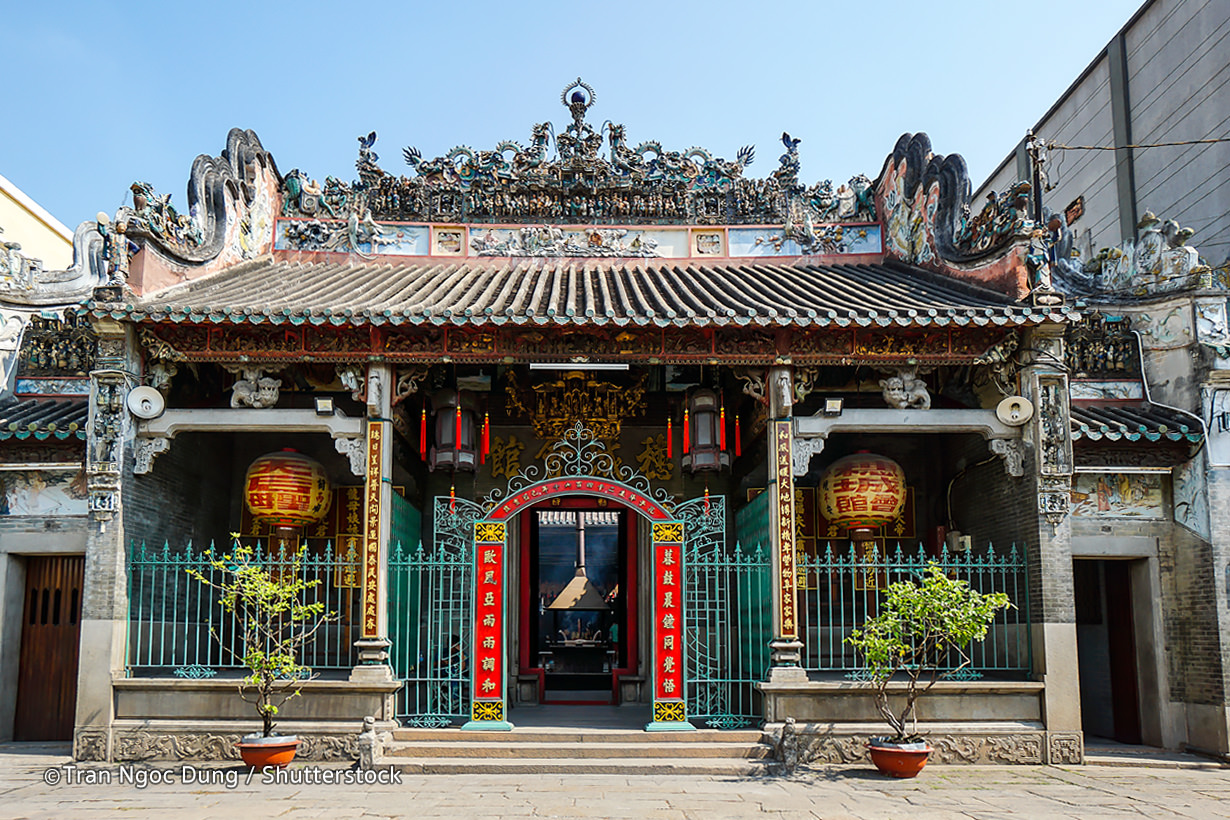
5. Notre Dame Cathedral Basilica of Saigon and the Post Office
Built from 1877 to around 1883, the cathedral was intended to be a place for the colonial missions to worship and a symbol of the power of the French colony.
The exterior consists of red bricks from Marseille, and the clock between the two bell towers was built in Switzerland in 1887.
Notable features of the interior include 56 squares of stained glass by Lorin from Chartres, France; the 12 pillars representing the 12 apostles; and one of Vietnam’s oldest organs. To see the interior, try visiting in the morning or attending a Sunday mass.
Across the street, the French colonial-style post office, completed in 1891, was designed by Gustave Eiffel, the French architect of the Eiffel Tower. Today, the post office is still in use and is a popular meeting place for locals.
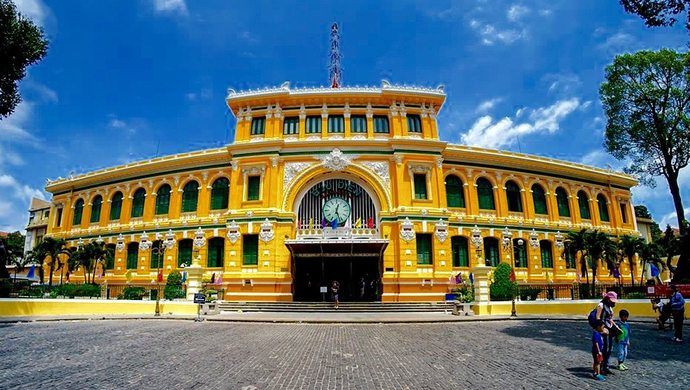
6. Saigon Opera House
Also known as The Municipal Theatre of Ho Chi Minh City, the elegant Saigon Opera House, at the start of the famous tree-lined Le Loi Avenue, is eye-candy for architecture buffs – especially fans of the French colonial style. It was built as Opera de Saigon in 1897 by Eugene Ferret, a French architect, to entertain French colonists, and its striking facade echoes the style of the Petit Palais, which was built in the same year in Paris.
After 1956, the building was used as the home of the Lower House assembly of South Vietnam and again became a theater in 1975, after the fall of Saigon. The only way to see the theater’s interior is to purchase a ticket to a show.
Both the Ho Chi Minh City Ballet Symphony Orchestra and Opera perform here, and tickets are available at the box office or local travel agents. In the area around the opera house are some of the city’s new shopping malls and exclusive hotels. You can also combine a visit here with the nearby Notre Dame Cathedral and Reunification Palace.
7. Reunification Palace
A visit to the Reunification Palace, once known as Independence Palace, is more about the historic events that took place here than any pomp and grandeur. In fact, this 1960s-style building, with its large, airy rooms and dated furnishings, seems frozen in time since April 30, 1975, when a North Vietnamese army tank crashed through the iron gates here, bringing an end to the Vietnam War. For locals, the palace represents this historic event and the reunification of the country.
Set on 44 acres of lush lawns and gardens, the palace also offers a fascinating glimpse at the lifestyle of privileged heads of state in 1960s Saigon. It was built on the site of the former Norodom Palace, which was bombed by fighter jets in 1962 in an unsuccessful assassination attempt on the South Vietnamese president Ngo Dinh Diem.
The current building was completed in 1966 and became the home and workplace of the successive president when Vietnam was split between the north and the south. Notable features include the president’s living quarters, the war command room with large maps and antiquated communications equipment, and the maze of basement tunnels.
You’ll also see military vehicles outside, including the fighter jet that destroyed the Norodom Palace, and tank 843, which rammed through the palace gate on that fateful day in April more than four decades ago. Guided tours in English are available
8. Ben Thanh market
Address: 32-30, 36-34-32-30 Phan Boi Châu, Ben Thành, Ho Chí Minh City
For sightseers, the hot and hectic Ben Thanh Market is almost an obligatory stop, even if only to witness the crammed stalls and market chaos. The stalls are piled high with everything from local delicacies, fish, flowers, and tropical fruits to shoes, clothes, colorful candy, and souvenirs. The markets are also notorious for pickpockets, so make sure any valuables are secure and out of sight.
After soaking up all the ambiance, head to Saigon Square, about a three-minute stroll away, for a slightly less frenetic shopping experience with the added bonus of air conditioning. Here, you’ll find fantastic deals on everything from clothing and backpacks to jewelry and shoes. Haggling is customary at both locations.
9. Museum of Vietnamese History
Address: 2 Nguyen Binh Khiêm, Ben Nghé Ho Chí Minh City
Within the grounds of the botanic gardens, the Museum of Vietnamese History unveils the country’s cultural evolution from the Bronze Age to the early 20th century. The exhibits are organized chronologically and include artifacts from Vietnam’s former ethnic groups, including the Dong Son, Funan, Khmer, and Cham civilizations. Particularly interesting are the stone and bronze sculptures, Angkor Wat relics, and the well-preserved mummy.
Almost as interesting as the museum exhibits is the building itself, which dates from 1929 and fuses French and Asian architectural styles. After viewing all the museum exhibits for an hour or so, you can enjoy a relaxing stroll around the botanic gardens.
10. Jade Emperor Pagoda
Address: Ða Kao Quan 1 Vietnam, 73 Mai Thi Luu, Ða Kao, Ho Chí Minh
Built in the early 20th century, the evocative Jade Emperor Pagoda (Chua Phuoc Hai) sits in an unassuming neighborhood a few blocks away from the Botanical Gardens. The temple was built in honor of the Taoist god, the Jade Emperor or King of Heaven, Ngoc Hoang, and within its dimly lit interior, you’ll see many representations of both Buddhist and Taoist deities.
As you step inside, incense shrouds the many local worshippers, and candles illuminate altars brimming with offerings. Of special note are the intricately carved panels of woodwork and the many elaborate dragon and animal sculptures adorning the roof.
At the temple’s entrance, masses of turtles swim in a pond, some with inscriptions on their shells, and for this reason, the temple is often called the tortoise pagoda. Locals come here frequently to worship, so it’s important to be respectful when you visit.
11. Ho Chi Minh City Museum
Address: 65 Ly Tu Trong, District 1, Ho Chi Minh City
Near the Reunification Palace, the Ho Chi Minh City Museum occupies an impressive Neoclassical building, formerly known as Gia Long Palace that was once home to the Cochinchina’s governor. It’s worth a stop for an overview of the city’s history and a look at the grand architecture, which includes Oriental and European flourishes.
The museum traces the city’s past with exhibits on the struggle for independence, nature and archaeology, trade, village handicrafts, currency, and the culture of Saigon. Interestingly, the building sits on a network of tunnels and bunkers, which served as escape routes for past dignitaries, though these are closed to the public.
12. FITO Museum
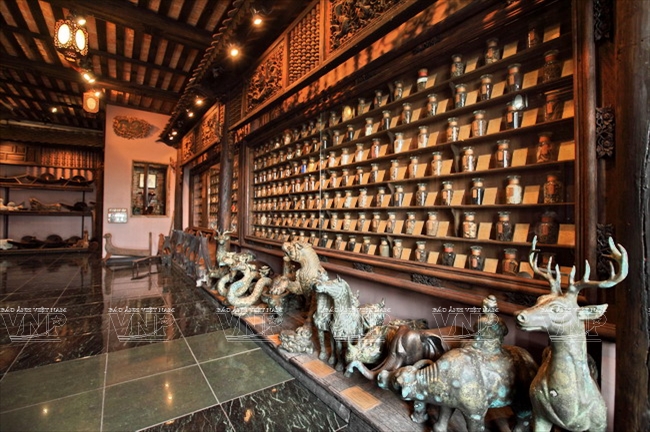
Although it’s a little challenging to find if you’re traveling without a guide, the first Museum of Traditional Vietnamese Medicine (FITO) occupies a beautiful old five-story building framed by bamboo. It’s worth a look for anyone who is interested in alternative medicine or wants to soak up some Vietnamese culture away from the main tourist trail.
The museum displays thousands of items relating to Vietnamese traditional medicine, from the Stone Age to the present day, including books, documents, herbs, and implements used in preparing the medicines. You can also try your hand at grinding up some of the ingredients. The presentation begins with a short film on the history of Vietnam’s traditional medicine, and herbal cures are available for purchase before you leave.
ALL THINGS YOU SHOULD KNOW BEFORE TRAVELLING HO CHI MINH CITY
How to travel to Ho Chi Minh City?Ho Chi Minh is the biggest city in Vietnam. Most of domestic and international flights land on this city. Furthermore, there are many transportations have in this city for traveler to choose.
1. By plane:
There are a lot of flights in and out Ho Chi Minh city from early morning till end of the date. So there are much choice for airlines to reach this city and travel in Vietnam. All flights has schedule to Vietnam land on Tan Son Nhat airport in Ho Chi Minh City.
Because it is the biggest airport in Vietnam and Indochina, so there are two separate airports: domestic and international one with distance 1km by car. However, it has the hallway to connect between two airports for walking now. When traveling to Ho Chi Minh, visitor should take note this so that avoids reaching the wrong airport area.
2. By train
Play the main point in Vietnam Railway. Most trains in and out from Ho Chi Minh city. There are many trains daily in and leave Ho Chi Minh city for choice.
- Touch the sky
- Ho Chi Minh City rooftop bar’s are a must while you are in the city.
- Enjoy the views from one of the Skybars the city has to offer with a drink on your hand.
- Chill: this was our favorite, as you can still see the traffic from the rooftop bar. We recommend going for sunset and see how the colors in the city change. After 12, it turns to a dancing club.
- Glow: offering drinks in in a beach club atmosphere, this Skybar attracts well-dressed expats and locals looking to dance.
- EON Heli Bar: Located in the Bixteco Financial Tower, it is the highest Skybar in Ho Chi Minh city.
- The View Rooftop bar: located in the backpacker’s street, Bui Vien Street. This rooftop bar is located in the 9th floor of Duc Vuong Hotel. It is known for being one of the cheapest skybar in the city.
WEATHER & BEST TIME TO COME TO HO CHI MINH CITY
Ho Chi Minh City has a tropical monsoon climate – it’s very much a typical steaming hot Southeast Asian metropolis where you can expect it to be either hot and dry or hot and wet.
Regardless of the time of year, you’ll never need more than one layer of clothing in this southeastern Vietnam city.
- Dry season
The offical dry season lasts from December to April. Temperatures are temperate at first but can climb up to 40°C at the end of April while remaining very humid.
- Wet season
The rainy season in turn, which runs from May to November, is characterized by violent but brief showers. The wettest period is from July to September
- The best time to visit Saigon
In Saigon, the annual average temperature is 27°C and never falls below 15°C. The best time to visit the city runs from December to March when it is dry and sunny. February is the month when it rains the least of the year while March and April are the hottest months with an average of 36 to 38°C.
Average temperature in Saigon through the year
FOOD MUST -EAT IN SAIGON ( Ho Chi Minh)
If there’s one city that’s absolute heaven for food lovers, it’s Ho Chi Minh. With a French influence in many of the dishes here, the food is fragrant and full of flavour. From steaming chicken noodle soups to crispy savoury pancakes and frothy coffees, the street food is fantastic. Check out our top dishes as follow¨1.Banh Mi
If you’re even the slightest bit into Vietnamese food, you’ve probably eaten numerous banh mi sandwiches.
Along with pho, easily the most exported Vietnamese speciality is Banh Mi. Although Banh Mi can mean a variety of different things, and in Vietnamese it actually just means bread, sometimes the term can be used to refer to any type of the beautiful Vietnamese personal baguette sandwich.
Walking around Saigon you’ll see dozens of carts with signs selling Banh Mi – it’s actually hard to go more than a block without seeing one – so it’s never hard to find.
There are many different varieties of Banh Mi, and here’s a good resource for seeing the different types, but the basic sandwich starts with a crusty baguette that’s sliced in half (sometimes using a scissors) and stuffed with layers of pork, luncheon meats, shredded cured pork skin, pâté, mayonnaise, Vietnamese radish and carrot pickles, a handful of sliced cucumbers, sprigs of coriander (cilantro), and last but not least, an optional, yet in my opinion necessary, scoop of fresh pounded chilies.
The sum of these ingredients together is what really makes Banh Mi such a glorious sandwich. Coming from Bangkok, where I can’t remember the last time I ate bread or a sandwich for that matter, I was pretty happy to devour as many Banh Mi as I could when I was in Vietnam.
- Bánh mì Huỳnh Hoa (hours: About 3:30 pm – midnight daily. Address: 26 Lê Thị Riêng, Ben Thanh, District 1, Ho Chi Minh City
- Bánh Mì Hồng Hoa(Open hours: I think open in the morning, I arrived at 8 am, and they seemed to be at their peak serving, so good place for breakfas
- Banh Mi 37 Nguyen Trai Open hours(From around 4:30 pm – 7:30 pm each day)
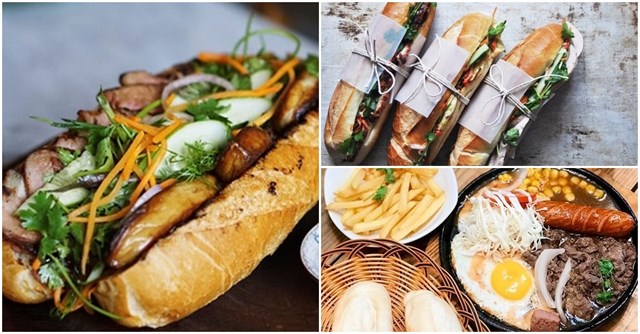
2. Pho
No matter if you’ve been to Vietnam before or not, you’ve likely heard of pho, if not already eaten it many times before.
The noodle soup didn’t become so famous for nothing – it really is one of the most common dishes in throughout the country, and it makes the Vietnamese food menu at nearly every sit-down restaurant too.
Pho is the combination of soft rice noodles in a soup broth, normally prepared with either bo (beef) or ga (chicken) – both of which can be extremely delicious, but I’m normally more of a beef kind of guy.
The noodles are flash boiled until soft, topped with your choice of meat, and often finished with a sprinkle of chopped green onions and sometimes sweet onions as well.
Where to try
- Phở số 01 Hà Nội (Open hours: All day and night – they are open 24 hours) Address: 25 Nguyễn Thị Minh Khai, Saigon, Vietnam
- Phở Phượng 25 (Open hours: 6 am – 9 pm daily – great for any meal) Address: 25 Hoàng Sa, District 1, Ho Chi Minh City (it’s located very close to the famous Lunch Lady of Saigon)
- Phở Hòa Pasteur(Open hours: 6 am – 9 pm daily – great for any meal) Address: 260 Pastuer, District 3
Vietnamese cuisine is brilliant for combining a contrast of flavors and textures into a single dish, and I think bun thit nuong, or better yet bun thit nuong cha gio, is a great example of this.
The dish normally begins with a handful of chopped up herbs and lettuce at the bottom of a bowl, then in goes fresh rice vermicelli noodles (similar to Thai khanom jeen noodles), then a few skewers of grilled pork are layered on that, and finally a sweet and salty fish sauce, and a scoop of oily chives and green onions, and pickles are all added on top.
If you get the bun thit nuong cha gio, in addition to everything already mentioned, you’ll also get a fried spring or two chopped up on top, which bumps the delicious-meter up another notch.
The noodles are soft and silky, the pork is tender, salty, and sweet, and the egg rolls (cha gio) add a beautiful crunch to everything.
Where to try
- Chị Thông Bún Thịt Nướng(Open hours: 7 am – 10 pm daily)
- Address: 195 Cô Giang, District 1, Ho Chi Minh City
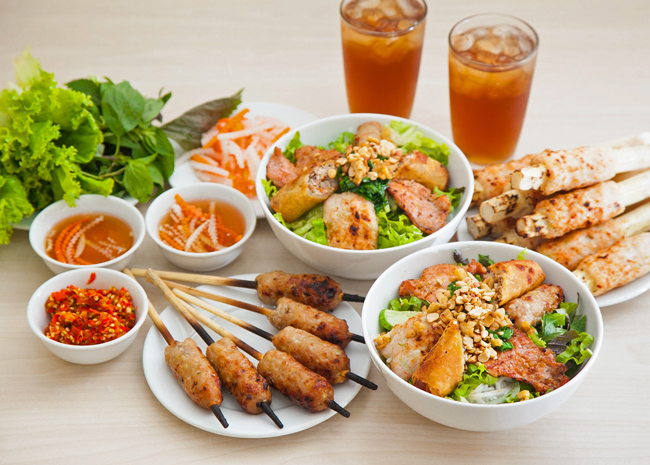
4. Chè (Sweet soup)
Desserts in Vietnam are generally different than most western desserts. Granted, there is the occasional baked item taken from the French and made into a Vietnamese version. However, there is one set of desserts that is inherently Vietnamese and that is Chè.
No, it’s not the rather famous beret clad revolutionary whose face is plastered on shirts all over Pham Ngu Lao. In fact, it’s a family of desserts. It may be served hot or cold in bowls, glasses, or over ice, and contain a range of ingredients ranging from a wide range of beans to tapioca, jellies, glutinous rice, and fruit. Let’s try
Chè ba màu: Literally translated as Dessert three colors, the main variant of this dessert is served with three types of coloured green jelly in slightly sweet coconut juice. The ingredients are usually served in layers and then mixed up when eaten and makes for a light yet refreshing snack.
Chè đậu đỏ bánh lọt: Kind of like the smorgasbord of the Chè family, this one has it all. It’s usually served with beans, jelly, and/or tapioca.
Sâm bổ lượng: More of a restorative than a dessert , this Chè can have dried red jujube, peanuts, taro, cassava, ginseng root, seaweed and/or water chesnuts. What also makes this dessert different is that there is no coconut milk in the syrup.
Chè Thái: A version of Thailand’s tub Tim grawb, the Vietnamese version is less sweet and uses a variety of fruits that can include jackfruit, longan, lychee, palm seed, and most importantly durian.
Chè trôi nước: This dessert is made with Mung bean paste in a dumpling made of glutinous rice flour that has a texture similar to mochi. It is served in a thick clear or brown liquid made of water, sugar, and grated ginger root.
- Add: 380 Nguyen Tri Phuong Str, District. 10. Tel: 09 3333 8128
- Add: 111 Bui Thi Xuan Str, Pham Ngu Lao D. 1. Tel: 08 38332748
- Add: 33 Dinh Tien Hoang Str, Binh Thanh Disctrict Tel: 08 3517 8333
- Add: 160 Nguyen Oanh Quan Go Vap HCMC. Tel: 08 6675 3882
- Or inside Ben Thanh market
Made from Vietnamese-grown dark roast coffee beans, the coffee is first brewed in a French-style drip filter (not our preferred style of coffee-making usually), which is poured into a glass of ice to which sweetened condensed milk is then added and stirred. (I’ll then add lots of sugar.) Sometimes the coffee is pre-made although traditionally it’s individually brewed for each customer in a small metal drip filter, called cà phê phin, which sits atop the coffee glass.
In Saigon, you’ll see Vietnamese coffee sold on virtually every second street block, at small stands usually manned by women, who temporarily turn a portion of the footpath into a pavement café. Tiny colorful plastic stools are scattered about the sidewalk or stacked up against a wall, and customers help themselves to a seat while they wait for their coffee. So you never have to walk far in the sticky heat for a caffeine hit and coolant.
If you’ve had enough of the heat and need some air-conditioning for a while, traditional Vietnamese iced coffee is also sold alongside Italian espressos, cappuccinos. So if your preference might normally be for a Starbucks experience, do the right thing and head to Highlands Coffee or Trung Nguyen instead.
- Trung Nguyen Coffee:6A Dong Khoi Str, District 1 & 128 Hai Ba Trung Str, District 1
- Highland Coffee: 75 Nguyen Du Str, Distric1 & 181 Ham Nghi Str, District 1
- L’Usine:151 Dong Khoi Str, District 1


